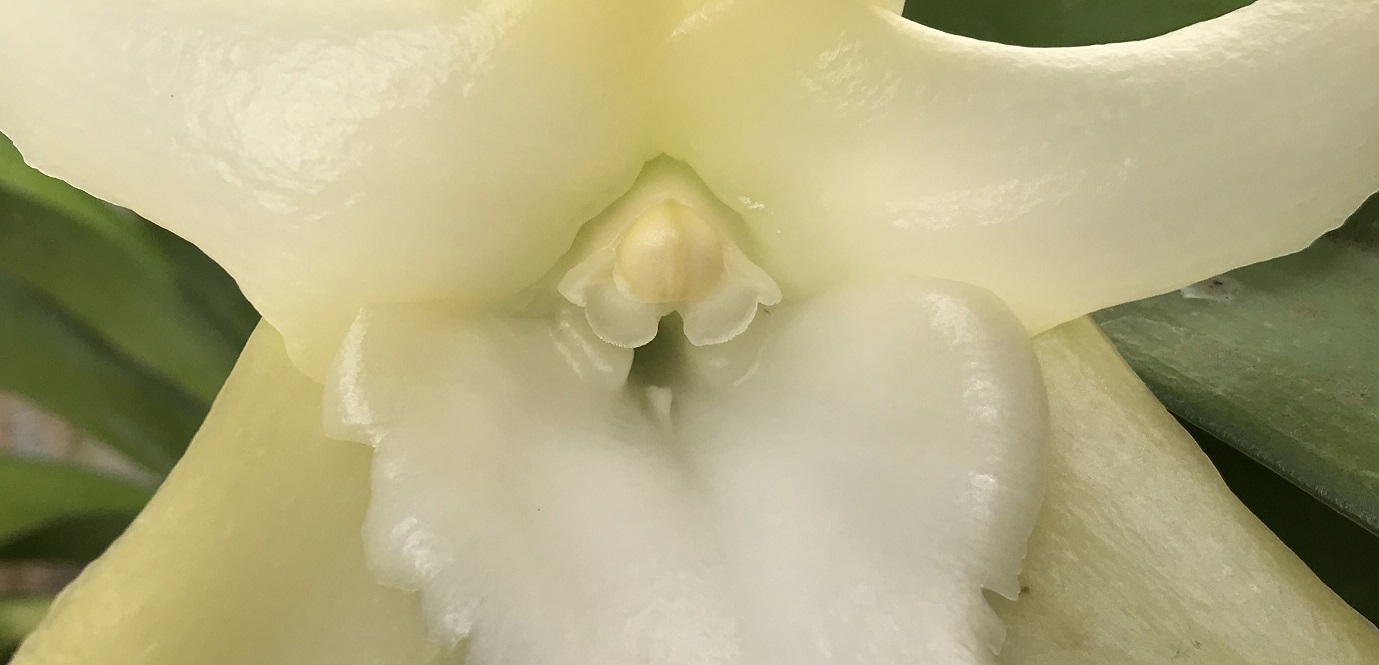
“The Angraecum sesquipedale, of which the large six-rayed flowers, like stars formed of snow-white wax, have excited the admiration of travellers in Madagascar, must not be passed over. A green, whip-like nectary of astonishing length hangs down beneath the labellum. In several flowers sent to me by Mr. Bateman, I found the nectaries eleven and a half inches long, with only the lower inch and a half filled with nectar…in Madagascar there must be moths with proboscides capable of extension to a length between ten and eleven inches. This belief of mine has been ridiculed by some entomologists…”
— Charles Darwin, 1862, On the Various Contrivances by Which British and Foreign Orchids Are Fertilised by Insects, and On the Good Effects of Intercrossing.
Next Friday, February 12, is Charles Darwin’s birthday and not coincidentally is also Darwin Day, commemorating the great man’s myriad contributions to science. It is therefore appropriate that my Angraecum sesquipedale, commonly called Darwin’s orchid, is flowering this week. Darwin’s prediction of a sphinx moth with a prodigious proboscis was elaborated by Alfred Russell Wallace in 1867, but Darwin was not proven correct until 1903. The moth in question, a subspecies of the African Xanthopan morganii, was named X. morganii praedicta, and it was finally photographed in the act of pollinating an Angraecum in 1992.
In his discussion of the pollination mechanism of Angraecum sesquipedale, Darwin suggested that the plant would be most efficiently pollinated if a moth were forced to push against the flower as it stretched for nectar at the bottom of a nectary that was lightly longer than the moth’s proboscis. On the other hand, a moth would be more likely to obtain nectar if its proboscis were longer than the nectary:
“As certain moths of Madagascar became larger through natural selection…or as the proboscis alone was lengthened to obtain honey from the Angraecum and other deep tubular flowers, those individual plants of the Angraecum which had the longest nectaries, and which, consequently, compelled the moths to insert their proboscides up to the very base would be best fertilized. These plants would yield the most seed, and the seedlings would generally inherit long nectaries; and so it would be in successive generations of the plant and the moth. Thus it would appear that there has been a race in gaining length between the nectary of the Angraecum and the proboscis of certain moths.”

More recent research suggests that Darwin’s hypothesis was at least partially correct (for review, see Johnson S.D. and Anderson B., 2010, Coevolution Between Food-Rewarding Flowers and Their Pollinators, Evolution: Education and Outreach 3: 32–39). Experimentally shortening the nectaries of other moth-pollinated flowers has confirmed Darwin’s hunch that they are most efficiently pollinated when the nectary is longer than the pollinator’s proboscis. It is also clear that there is an advantage in having a proboscis long enough to reach all of the nectar in deep flowers. However, flowers and pollinators may not be the only players in this evolutionary scenario. Darwin forgot predators.
When a sphinx moth with a very long proboscis feeds from a shorter nectary, the moth can maintain its distance from the flower and often engages in behavior called “swing-hovering”. This side-to-side movement is thought to be a response to predators, including spiders, which could trap a moth that is immobilized against a flower (Wasserthal L.T., 1997, Botanica Acta 110: 343–59). Thus, predators might drive the evolution of proboscis length sufficient to allow swing-hovering while feeding, and proboscis length would drive the evolution of longer nectaries–which would then drive the evolution of an even longer proboscis, if the longer nectary made moths with shorter proboscises more vulnerable to predation. This predator hypothesis remains unproven in the absence of direct observation of spiders or other predators attacking sphinx moths on Angraecum flowers. However, there is this:

Quite apart from its fascinating position in the history of science, Angraecum sesquipedale is worth growing for its beautiful flowers and nocturnal fragrance. It isn’t a particularly difficult orchid to grow and will thrive if given Cattleya light and Phalaenopsis temperatures. Angraecoids notoriously dislike root disturbance, so it is best to use a potting mix that will last a long time. My current plant is in a mix of coarse Orchiata (Pinus radiata bark) and red lava rock, but I have also grown plants successfully in pure lava rock.
There seem to be two forms of the species with distinct flowering times, but it is not always obvious which form is being sold by a particular nursery. One form flowers in winter (late December-February) and the other in spring (often around Easter), but there are no significant morphological differences between the two forms. The winter-flowering form is sometimes in bloom for Christmas (hence its alternative common name, star of Bethlehem orchid), but I have more often seen the hybrid Angraecum Veitchii (A. sesquipedale x A. eburneum) flowering in December.
A. sesquipedale eventually becomes very large and ungainly, but seedlings start flowering relatively young and small. One way to avoid having your growing area swallowed up by a giant Angraecum is to replace your plant every five or six years. Sell the big plant, buy a small seedling, and pocket the price difference.


